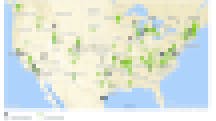Call to mind some of the dominant narratives about school innovation and chances are a fairly predictable picture emerges. It’s not hard to conjure up a charter school launched anew in California or perhaps Chicago with students working through personalized learning playlists in colorful and modular furniture—and plenty of technology.
But that’s hardly the full story. For many educators, the landscape of school innovation is widely varied. All across the country, schools of all stripes are developing nontraditional approaches to teaching and learning to better serve students. Some are wrapping social and health services around academics to ensure students have the supports they need to focus on learning; some are redefining metrics of success to include social-emotional competencies; and others are finding ways to allow students to earn credit based on learning experiences outside the classroom.
These schools are located all over the country and their demographics are often as varied as the approaches. School innovation is living, dynamic and diverse—especially from the perspective of those engaged directly in it.
Unfortunately, it can be hard to see exactly where and how these new approaches to teaching and learning are evolving, and too much of the diversity in school innovation gets lost in the education echo chamber. As a result, a limited number of schools and models tend to be highlighted as exemplars, time and again. Funders, researchers and intermediary organizations are eager to learn about where schools are bucking the traditional model. But currently, they tend to rely on word-of-mouth and other network-based strategies to discover schools.
In short, missing the diversity of innovative school practices also means missing models that have the potential to transform the learning experience and drive better outcomes for students. Clearly something needs to change.
Over the past year, the Christensen Institute, where I serve as a research fellow, has worked with a collective of partners and advisors to create a process that breaks school innovation out of the echo chamber and paints a more comprehensive, diverse picture of approaches across the country. We’re calling the project the Canopy, as a way to envision both the trees—individual schools as units of change—and the diversity of the whole “forest” of schools that are moving away from the traditional model.
Casting a Wide Net
To get beyond the well-known, word-of-mouth schools we’re already familiar with, we tested a crowdsourced school nomination process that deliberately included nominating organizations in every U.S. state. Before we identified individual schools, we began with a “snowball survey,” asking a select number of colleagues for their go-to organizations to learn about innovative schools. These organizations included over 300 regional coalitions, state agencies and national intermediaries—and 76 of them ultimately helped nominate the schools they thought were making a difference. (EdSurge was one of them.) Later, we asked the leaders of nominated schools to verify details.

Ultimately, this process succeeded in surfacing a number of under-the-radar schools: 72 percent of schools in the Canopy do not appear on other commonly-referenced lists and databases of innovative schools, such as Education Reimagined’s map, Getting Smart’s 2018 list of schools to visit, and Jobs for the Future’s Students @ the Center Hub map.
Here’s a little on how that process worked.
Defining Innovation Broadly
To ensure nominators understood that we were seeking to surface more diversity among schools that are innovating, we used a deliberately broad framing for what makes a school “innovative.” The nomination form asked organizations to consider schools that are making strides towards student-centered learning through personalization, new definitions of success and/or equity for historically marginalized students. Nominated schools could be newly launched schools or redesigns, but could also be traditional schools that are adopting coherent, leadership-backed approaches to student-centered learning. (To be clear, we focused on innovative approaches at this stage and not evidence or outcomes of success.)
In total, the data represents schools pursuing 88 practices linked to non-traditional school design, ranging from multi-age classrooms and restorative justice programs to competency-based education and project-based learning.
Structuring School Design Data Consistently
Because existing databases on school innovation often use inconsistent terminology to describe similar things—i.e., project-based learning versus real-world learning—data on school practice is fragmented. This project tests a consistent data lexicon to enable researchers to analyze national data and see trends and patterns over time. Building from work that other organizations have done (including EdSurge) we developed a set of “tags,” or keywords and phrases representing aspects of school design that nominators and school leaders applied to each school’s nomination to describe elements of the school’s model.
While tags will never deliver a high-resolution view of what’s happening, they capture key design elements so that the dataset can be sorted, filtered and analyzed, making it much more than just a list of schools.
For example, this tagging system, which is currently available for download, helped uncover that the three most commonly-cited approaches among schools in the Canopy were learner agency, social-emotional learning and project-based learning. However, learner agency and social-emotional learning were indicated at far lower rates among schools serving predominantly Black students. While findings like these are not fully representative and do not reveal the cause behind these patterns, they offer a glimpse into important questions worthy of further investigation.
This initial stage of the project has not single-handedly painted a comprehensive picture of school innovation, but it could, over time, as additional researchers build upon its research methodology and living lexicon. It is a compelling proof-of-concept for how a process designed to advance collective knowledge—both in terms of where that knowledge comes from, and how it is structured—could reliably surface a more diverse set of schools and unearth trends and patterns in how schools are reimagining teaching and learning.


